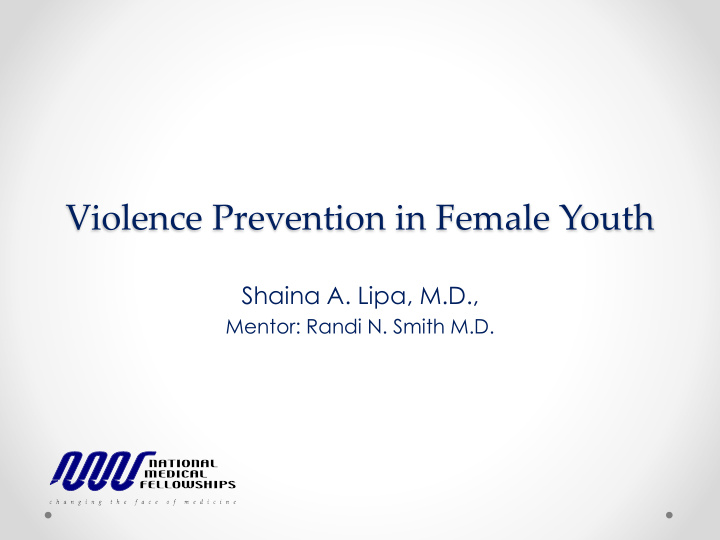



Violence Prevention in Female Youth Shaina A. Lipa, M.D., Mentor: Randi N. Smith M.D.
Introduction Youth violence in our country is a daily occurrence with • devastating consequences To help combat interpersonal violence amongst youth, several • violence intervention programs have emerged at hospital trauma centers and in communities across the country Typically victims of interpersonal violence are male in their • second or third decade of life, from underrepresented ethnic minority backgrounds and live in urban areas These violence intervention programs, in general, cater to the • prototypical victim of interpersonal violence but oftentimes do not specifically address gender Between 2008-2009 young men experienced an 8.5 percent • reduction, while young women saw only a fall of 1.5 percent
Introduction This disparity in the violence reduction rate may suggest that • our intervention programs are not targeting young women as effectively as young men, which should lead to consideration of gender-specific interventions Ignoring the complex societal factors which greatly impact • women’s daily lives precludes the design of optimally effective interventions
Objectives We hypothesize that females are not as well served by gender • neutral violence intervention programs and would theoretically benefit from gender-specific case management that addresses their unique risk factors for violence and injury recidivism We aim to demonstrate that young women would benefit • from gender-specific violence intervention programs
Methods A secondary violence prevention program in Alameda County • This program focuses on eliminating risky behaviors through positive case • management services Specifically, this program is targeted towards young women who have been • identified as high-risk for violence by the Alameda County Juvenile Justice System Young women were identified as high-risk if they had been convicted of a • criminal act In order to participate in the program, the young needed to be on probation • for the crime and could not be incarcerated Inclusion Criteria • Female o 10-24 years old o Convicted of a criminal act o Currently on probation for a criminal act o Exclusion Criteria • Currently incarcerated (because these youth would be unable to attend o the required weekly meetings)
Methods The violence intervention program consisted of weekly group sessions for • 5 weeks There were about 10-12 young women who were participants in the • group session Each session stressed the importance of abstaining from violence and • the impact of violence on individuals and the community In addition, each session had a specific topic and a weekly writing • assignment that the young women had to complete prior to the session The assignments focused on the following topics: introductions, future • goals, obstacles to future goals, steps to obtaining goals, and lastly the impact of program participation on lifestyle change Each participant would read her writing assignments aloud to the group • Following the reading of the writing assignments, there was open • discussion about the assignment The sessions always ended with a guest speaker from the community • These speakers included female community leaders who were women of • color in professions such as, firefighters, police officers, nurses, physicians, and entrepreneurs
Results From February to June, there were 4 groups that • completed the 5-week program The results of the program qualitatively showed the • following: The young women reported that they felt very comfortable sharing their writing o assignments in the all-female groups because they felt as if they were able to freely share the more intimate details of their lives They reported feeling as if the group sessions helped them to realize the o impact of violence on individuals and specifically their communities They reported that the group sessions helped them to identify areas in their o lives that needed to be changed They also felt as if the group sessions helped them to identify obstacles to o change and strategies to overcoming those obstacles They reported that they had a lack of female role models they could relate to o and that the various female community leaders at the group sessions were inspirational and helped that to see that there were alternative lifestyles to the ones that they had been living
Conclusions Overall, the program was successful • The majority of the young women left with completely different • outlooks on life than when they initially presented to the program By engaging in the program, these young women understood the • impact of violence on individuals and communities , which seemed to impact their decisions to make positive life-changes The all-female group allowed the women to feel more • comfortable sharing their writing assignments Many of these women had complex social situations that • involved histories of rape and sex trafficking that caused them to have a distrust of men It is complex social situations and gender differences such as • these that need to be further explored when tailoring violence intervention Positive female role models are invaluable and essential to • lifestyle changes
Future Considerations There has not been any longitudinal data collected thus far, • but the plan is to collect data on the recidivism rate of inter- personal violence in the young women who participated in this program Through more quantitative data, we would like to continue to • identify the gender-differences that need to be identified in order to effectively target the female population
Acknowledgments • California Community-Service Learning Program • The California Wellness Foundation • National Medical Fellowships • University of California, San Francisco School of Medicine • Randi Smith, M.D. • Mr. Kevin Grant • Alicia Fernandez, M.D.
Recommend
More recommend